Design of cost allocation rule for joint replenishment with controllable lead time
2021-01-12ShiXuefeiWangHaiyan
Shi Xuefei Wang Haiyan
(School of Economics and Management, Southeast University, Nanjing 211189, China)
Abstract:To encourage retailers to form cooperative alliances to jointly replenish inventory, considering that the supplier provides a flexible lead time and quantity discount to retailers, a model of average total cost per unit time of periodic joint replenishment is constructed, and an approximate algorithm, which can satisfy the requirement of any given precision, is given. The cost allocation rule in the core of the joint replenishment game is designed based on the cooperative game theory. The numerical experiment results show that the proposed algorithm can quickly solve the joint replenishment problem when the item number is not greater than 640. The retailer’s cost saving rate is always greater than 0, and it increases with the increase in quantity discount and fixed cost after adopting the given cost allocation rule. With the increase in the safety stock level, the retailer’s cost saving rate increases first and then decreases; and the retailer’s cost saving rate increases with the increase in the size of the alliance, but it decreases as the number of product category increases. The proposed cost allocation rule can reduce the retailer’s cost up to 20%, which is conducive to forming a cooperative coalition.
Key words:joint replenishment; controllable lead time; cost allocation; cooperative game
Joint replenishment is an important method to reduce purchasing costs, which has been adopted by many enterprises. For example, Suning and Tmall first jointly purchased some goods in 2016 to save procurement and management costs. Baiyun Mountain and other six pharmaceutical enterprises plan to set up a joint procurement platform to introduce agents and strategic products for each member enterprise and reduce enterprises’ purchasing costs. The General Motors and Peugeot Citroen Group (PSA Peugeot Citroen Group) announced a global purchasing company with estimated annual savings of two billion dollars through joint procurement of raw materials and standardized components[1]. In 2019, the Beijing, Tianjin and Hebei Medical Insurance Bureau jointly issued Beijing-Tianjin-Hebei medical consumables combined with the procurement work opinion, which is expected to be included in the pilot scope of medical consumables varieties, and the reduction of price was more than 50%. Due to the inconsistency of lead time and replenishment cycle, the same product has the same replenishment cycle when the enterprise carries out joint replenishment. The fixed cost of replenishment is shared among the enterprises. Therefore, it is necessary to minimize the cost of joint replenishment per unit time and solve the cost allocation problem.
The research on joint replenishment has been mainly devoted to optimizing total costs and searching for the replenishment cycle of the cooperative alliance. Joint replenishment can be defined as reducing procurement costs by coordinating orders for multiple products to achieve economies of scale[2-3]. It can also be defined as retailers placing joint orders with one supplier to reduce purchase prices and save ordering costs[4]. Therefore, joint replenishment is regarded as a joint order of one or more items to reduce replenishment costs. It includes the joint replenishment of a single item[5]and the joint replenishment of multi-items[6]. The joint replenishment of a single item usually considers multiple periods in the research, and products of all retailers are ordered together. Multi-items joint replenishment strategies include the direct grouping strategy and the indirect grouping strategy. The direct grouping strategy means that products are randomly divided into the set group; the restocking cycle of the same group of products is the same; and the replenishment cycle of each group needs to be decided[7]. The indirect grouping strategy is to set a basic replenishment cycle. The replenishment cycle of all products is the integer times of the basic replenishment cycle, and the decision maker needs to make decisions on the basic replenishment cycle and each product cycle[8]. From the point of view of replenishment costs, van Eijs et al.[9-10]considered that the indirect grouping strategy is better than the direct grouping strategy.
Cost allocation is another research direction on joint replenishment, and the rationality of the cost allocation scheme will directly affect whether joint replenishment can be carried out and implemented. Meca et al.[11]designed the cost allocation scheme based on the cooperative game theory for joint replenishment with deterministic demand, no major setup cost, and zero lead time. Anily et al.[12]proposed a cost allocation scheme of joint replenishment with deterministic demand and zero lead time. Dror et al.[13]put forward the concept of product aggregation and pointed out that the core of the corresponding cooperative game is non-empty. Dror et al.[14]further analyzed the sensitivity of the parameters of the joint replenishment problem of the inseparable product set, and concluded that the game’s indivisibility occurs more likely than the concave. Ye et al.[15-16]presented the EOQ model of joint replenishment interval value and put forward the allocation scheme of proportion surplus allocation value. They also proposed the EOQ model of joint replenishment interval-value considering shortage cost and the cost allocation method of the variable-weight Shapley value. Chen et al.[17-18]constructed the linear programming model of joint replenishment and gave the allocation scheme of dual solution. Although some cost allocation rules are given in the above literature, cost allocation rules are generally not universally applied owing to some flaws. For example, the Shapley value with the large scale of the cooperative alliance is obtained after a long time and it may not be in the core of the corresponding cooperative game. Also, only by constructing a linear programming model, can the dual solution be guaranteed to be in the core of the cooperative game. Furthermore, there is a limitation in the literature on the cost allocation scheme of joint replenishment. The lead time is assumed to be zero in those studies, which is an ideal situation but is rare in practice. Most of the literature on joint replenishment considers deterministic lead time[19-20]or zero lead time, and only a few papers on joint replenishment consider random lead time[21-22], since the random lead time makes the joint replenishment model more complex.
In recent years, some scholars have paid attention to the joint replenishment problem with a controllable lead time. Braglia et al.[23]pointed out that how to control the lead time and ordering cost was an important problem in random inventory replenishment. Shortening lead time can reduce safety inventory and improve customer service[24]. Tersine[25]pointed out that the lead time include the cycle time of multiple processes, such as order processing, product processing, transportation and delivery, which can be accelerated by investing more costs. Therefore, the lead time, to a certain extent, can be shortened. In other words, it is controllable. Marcello et al.[26-27]studied the joint replenishment problem with a controllable lead time, in which the lead time can be shortened by crashing costs. More crashing costs of investment will lead to a shorter lead time. Those papers aim to minimize the cooperative coalition’s cost, which means that the joint replenishment is formed through cooperation.
To the best of our knowledge, there is no literature on the study of the cost allocation scheme of the joint replenishment problem with a controllable lead time. It is necessary to design corresponding allocation scheme that satisfies fairness and feasibility. Therefore, this paper will construct a model of the joint replenishment problem with a controllable lead time, make decisions on the joint replenishment cycle and replenishment quantity, and design the cost allocation scheme for the corresponding joint replenishment. The crashing cost function adopts the function used by Chen et al.[28-29]. Moreover, this paper also considers the quantity discount[30], which is very common in the inventory replenishment problem. The fixed cost independent of the product type and the replenishment quantity are considered, and the fixed cost related to the product type and independent of the replenishment quantity is assumed to be 0. Therefore, the problem considered in this paper is actually an extension of the cost allocation problem of Meca et al.[11], and this paper considers the flexible lead time and multi-items in the joint replenishment problem.
In this paper, first, the long-run average cost model and the corresponding joint replenishment model of multiple retailers ordering periodically under the condition of nonlinear quantity discount and controllable lead time are established. Then, an approximate algorithm is given to solve the model. Finally, the cost allocation rule in the core of the joint replenishment game is presented.
1 Problem and Model
A supplier suppliesnitems tomretailers located in the same area. LetN={1,2,…,n},M=1,2,…,m. The supplier provides a flexible lead time for retailers, and charges retailers a fee for the corresponding lead time. The fee is called the crashing cost, which is used for expediting order processing, production and shipping. LetLjbe the lead time of retailerjwherej∈MandLj∈[lmin,lmax],lmax>lmin>0. The corresponding crashing cost isC(Lj)-θ,θ>0. The orders of retailerjare placed together, and retailerjmakes decisions on the lead time and replenishment cycle length to minimize the average total cost per unit time cost when he/she replenishes inventory separately. When some retailers form a coalition for joint replenishment, they make joint decisions on the uniform replenishment cycle length and lead time to minimize the average total cost per unit time cost of the cooperative coalition, as shown in Fig.1.
Joint replenishment not only helps retailers share the fixed cost but also helps them obtain a greater discount from the supplier. Assume that there is a trusted leader to help retailers form a cooperative coalition to jointly replenish inventory. To form a cooperative coalition for reducing their total cost, the following two problems need to be solved: 1) How to make decisions on the lead time and replenishment cycle length to minimize their total cost?
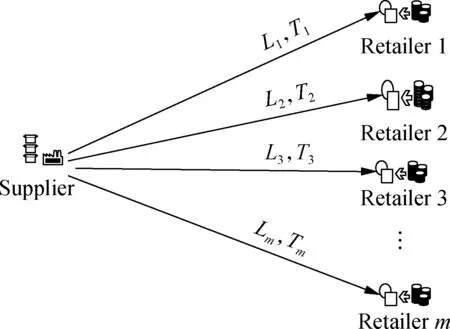
(a)
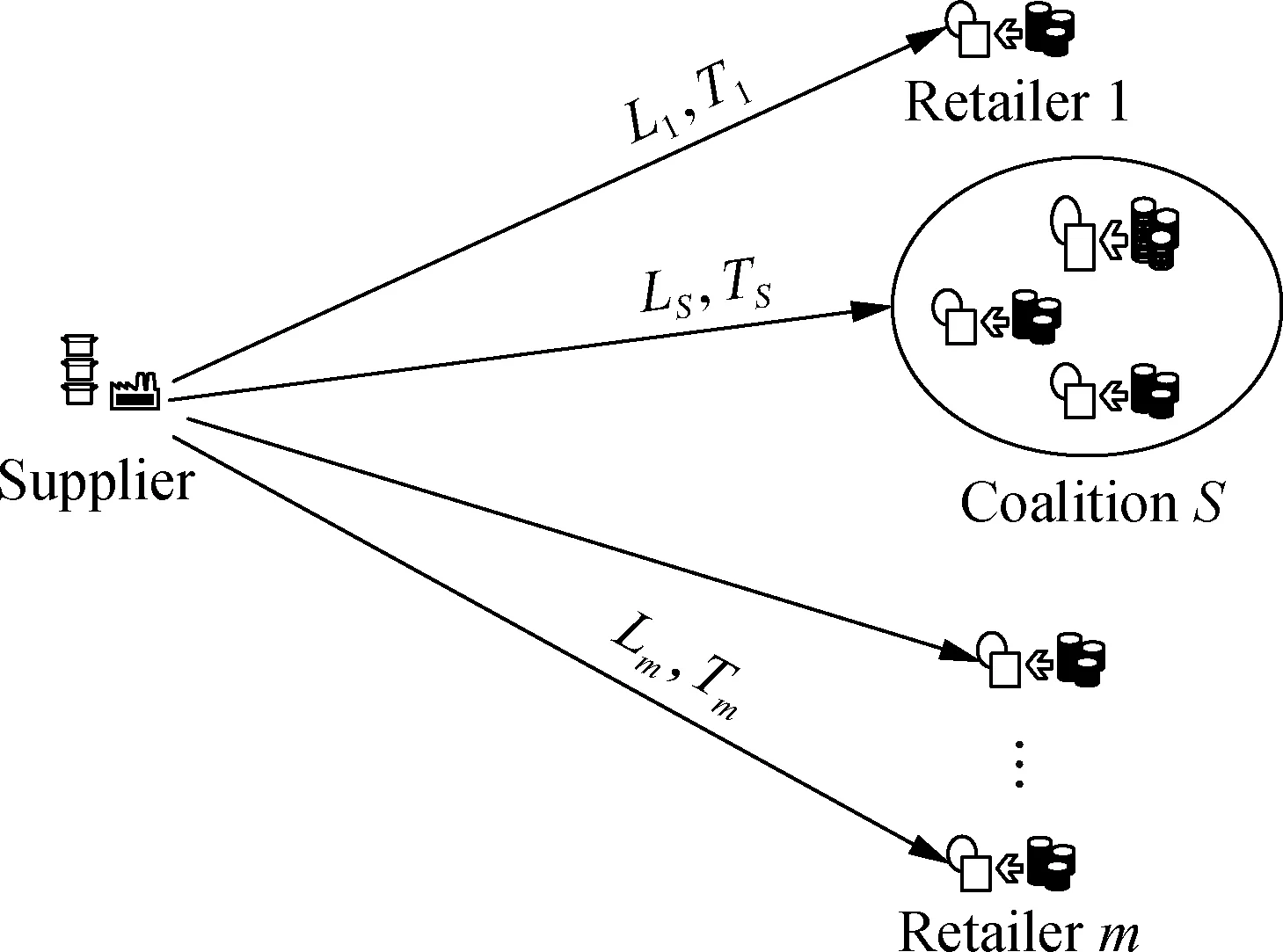
(b)
and 2) How to allocate the total cost incurred by joint replenishment in fairness and rationality?


Let TCj(Lj,Tj) be the average total cost per unit time of retailerj, and it can be expressed as
Then, the objective of retailerjis
In the above expression, the range of lead time is limited since the lead time is usually larger than 0 and cannot be infinite even if there is no crashing cost.LjandTjare the decision variables of retailerj.
Joint replenishment without considering the consolidation cost does not change their cost structure, but it requires retailers to share the lead time and replenishment cycle length. Therefore, if retailers form coalitionSwhereS⊆Mto jointly replenish inventory, coalition S makes decisions on the uniform lead timeLSand replenishment cycle lengthTS. The average cost per unit time of coalitionSis
and the minimum of the average total cost per unit time is expressed as
(1)

2 Decision on Lead Time and Replenishment Cycle Length of Joint Replenishment
The previous section presents the inventory replenishment model of retailerjand the joint replenishment model of coalitionS. The solution method of those models will be presented in this section.


where



Proof

iable in [0,+∞), and then
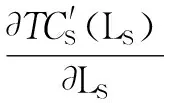




Hence,
Then, we have
According to Proposition 2, the error can be estimated by the difference between the optimal lead time and the approximate optimal lead time. Then, Algorithm 1 is proposed to search the approximate optimal solution. Let [x] be the smallest positive integer that is not less thanxwherex>0.
Algorithm1
Input:M,N,hi,A,ρ,λji,ci,Qi,W,lmin,lmax, and the percentage errorη.
While (k≤K)

end
k←k+1
end
Return results.
Proposition3The percentage error of the lead time obtained by Algorithm 1 does not exceedη.


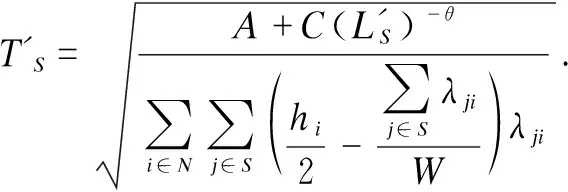
3 Cost Allocation for Joint Replenishment
The joint replenishment model and the solution to the joint replenishment model are presented in the above sections, but they are based on a cooperative coalition that has been formed. Retailers can choose cooperation and non-cooperation before an action, and retailers will not participate in cooperation without sufficient motivation. Generally speaking, retailers’ actions are driven by their interest, and cost savings is the motivation for retailers to participate in cooperation. On the other hand, retailers also pay attention to the fairness of cost allocation when choosing whether to cooperate. The cost allocation rule ensures that the cost savings for retailers is fair and reasonable, and it will also be the motivation for retailers to participate in the cooperation. The cost allocation in the core of the cooperative game is a relatively fair and reasonable allocation scheme, so the cost allocation scheme is designed based on the cooperative game theory. The replenishment game is a cooperative cost game[31]and the cooperative cost game is introduced before designing the allocation rule.
The replenishment game is a cooperative cost game. A cooperative cost game is defined as (P,v) wherePis a set of players andvis a real-valued set function (characteristic function) which maps the subsetsSof the setPinto the set of real numbers.v(S) expresses the total cost of coalitionS, so doesv(φ).
The cooperative game’s core is an important concept in the cooperative game theory since it is the set of solutions satisfying efficiency, individual rationality and coalition rationality. Efficiency means that the whole cost of the coalition is allocated to just the retailers. Individual rationality is that retailers have reduced their cost after cooperation. Coalition rationality is defined as a no sub-coalition which can save more costs after departing from the grand coalition where the grand coalition means that all retailers participate in the joint replenishment. Letξ=(ξ1,ξ2,…,ξ|P|) be an allocation of cooperative game (P,v), where |P| is the number of elements of setP. Then, we have the following formulae if it is in the core of cooperative game (P,v):
(2)
(3)
SinceSincludes the singleton set {j},j∈P, the inequation (3) includes individual rationality and coalition rationality. The allocation ruleξis called the core allocation rule.
Only when the cost allocation rule is known before cooperation, then the retailer decides whether to participate. Improper cost allocation rules may cost retailers more than they want, and it is an obstacle for forming the coalition. Therefore, this section works on the design of cost allocation based on the total cost that has been incurred.
Proposition4The joint replenishment game (M,φ) is subadditive.


The following inequality can be obtained in the same way.
So,φ(U)+φ(V)>TCU∪V(L*U∪V,T*U∪V)=φ(U∪V).
By Proposition 4, we haveφ(U∪{i})<φ(U)+φ({i}), so there are no dummy players who have made no contribution to the coalition because everyone in the coalition is helpful for reducing the cost of coalition. It implies that the more retailers take part in the coalition, the more cost savings incurred. Therefore, we aim to encourage all retailers to participate in joint replenishment for maximizing the cost savings of the joint replenishment. It requires fair and reasonable allocation rules to motivate retailers to participate in joint replenishment.
First, the allocation rule ensures that retailers’ costs are reduced after cooperation, and all the costs incurred by the coalition should be allocated to retailers. Secondly, under the same rule, no smaller coalition can cost less than that they are allocated from the grand coalition; otherwise, they will leave the large coalition and form a smaller coalition. Such a rule can be considered as fair and reasonable, and the solution in the core of the joint replenishment game satisfies such conditions. So, we try to find a solution for the core of the joint replenishment game.
Letζ={ζ1,ζ2,…,ζm} be an allocation vector whereζjis the total cost allocated to retailerjin joint replenishment game (M,φ).
Theorem1The allocation vectorζ={ζ1,ζ2,…,ζm} is in the core of joint replenishment game (M,φ) where

So, the allocation rule satisfies efficiency. Then,

So, the allocationζ={ζ1,ζ2,…,ζm} satisfies individual rationality and coalition rationality.
In summary, the allocation is in the core of the joint replenishment game (M,φ). Proof is complete.

4 Numerical Experiments
This section verifies the effectiveness of the solution method and the cost allocation rule through some numerical experiments.
4.1 The computational time of solution
Computational time is a measure of the solution method. Too long a computational time may render the solution method infeasible. Therefore, it is necessary to test the computational time of different product types and their accuracy to observe the solution method’s feasibility. Since the method for solving the joint replenishment problem is the same as that of the replenishment model without cooperation, we only do the test of the computational time for the replenishment model without cooperation, i.e., only one retailer. The number of items is 10, 20, 40, 80, 160, 320, 640, and the accuracy of the solution is 0.1, 0.01, 0.001, and 0.000 1, respectively. Since those parameters exceptlminandlmaxdo not affect the computational time of the algorithm, those parameters’ value for this section can be set as follows:A=100,C=100,W=10 000,ρ=1,θ=2. The computational time increases with the increase in the valuelmax-lmin. We set the valuelmax-lminlarge enough so that the optimal lead time is in [lmin,lmax], and then letlmin=1,lmax=100. Other parameters’ values are generated randomly by the Matlab random function. The demand arrival rateλjiis randomly generated in [0,10];hiis randomly generated in [1,2]; andQiare randomly generated in [5 000,5 500]. Tab.1 shows the computational time for a different number of items and percentage error.
The computational time is the time that it takes to search for the approximate value. After fixing the items’ number, retailers’ number and percentage error, each test was carried out 10 times, and we took the average computational time. Tab.1 shows that the solution time increases rapidly with the increase in the number of items and it increases with the decrease in the percentage error. However, it also shows that when the number of items is 640, the percentage error is 0.000 1, and the solution time is about 627 s, which means that the problems with no more than 640 kinds of items and no less than 1×10-6error can be solved quickly. It can run faster if we narrow down the search length of lead time since we find that the search area is relatively large, and all the lead times we obtain are not greater than 5, which means thatlmax=100. Therefore,lmax=10 is a more appropriate parameter value.

Tab.1 Computational time s
4.2 The computational time of solution
This section mainly analyzes the impact of ordering cost, safety inventory level and quantity discount on retailer cooperation income. Take five retailers and five products as an example, and the main parameters of the example are set as follows:A=100,C=100,W=10 000,ρ=1,θ=2,lmin=1,lmax=10.Q=[5 298, 5 148, 5 062, 5 194, 5 408],h={1.38, 1.63, 1.36, 1.41, 1.37},c={7.68, 2.33, 5.87, 4.59, 8.61}. The average demand arrival rate of five retailers are {2.98, 5.34, 5.07, 2.04, 7.75},{4.97, 5.74, 3.81, 8.14, 1.65}, {8.99, 4.13, 0.65, 3.93, 9.12}, {5.01, 0.15, 3.59, 0.54, 3.19}, {2.77, 7.03, 2.35, 3.75, 3.30}, respectively. We observe the trend of cost savings and cost saving rate when parameter values change in this section. The cost savings is the total cost generated by non-cooperation minus the cost to be borne after cooperation. The cost saving rate is the ratio of cost savings to the total cost generated by non-cooperation. The higher cost saving rate leads to a better cooperation effect.
First, we observe the effect of increasing fixed costAon the cost of retailer 1. From Fig.2, it can be observed that the cost savings increases gradually with the increase in the fixed cost, but the increment decreases gradually. Fig.2 also shows that the cost saving rate is also increasing but stabilizing faster. When the fixed cost exceeds 5 000, the cost saving rate is greater than 30. It implies that the higher fixed cost may lead to retailers’ increased willingness to participate in joint replenishment in the view of cost.
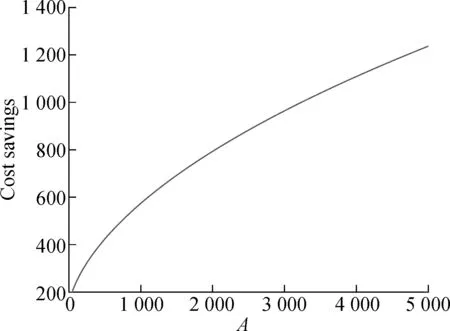
(a)
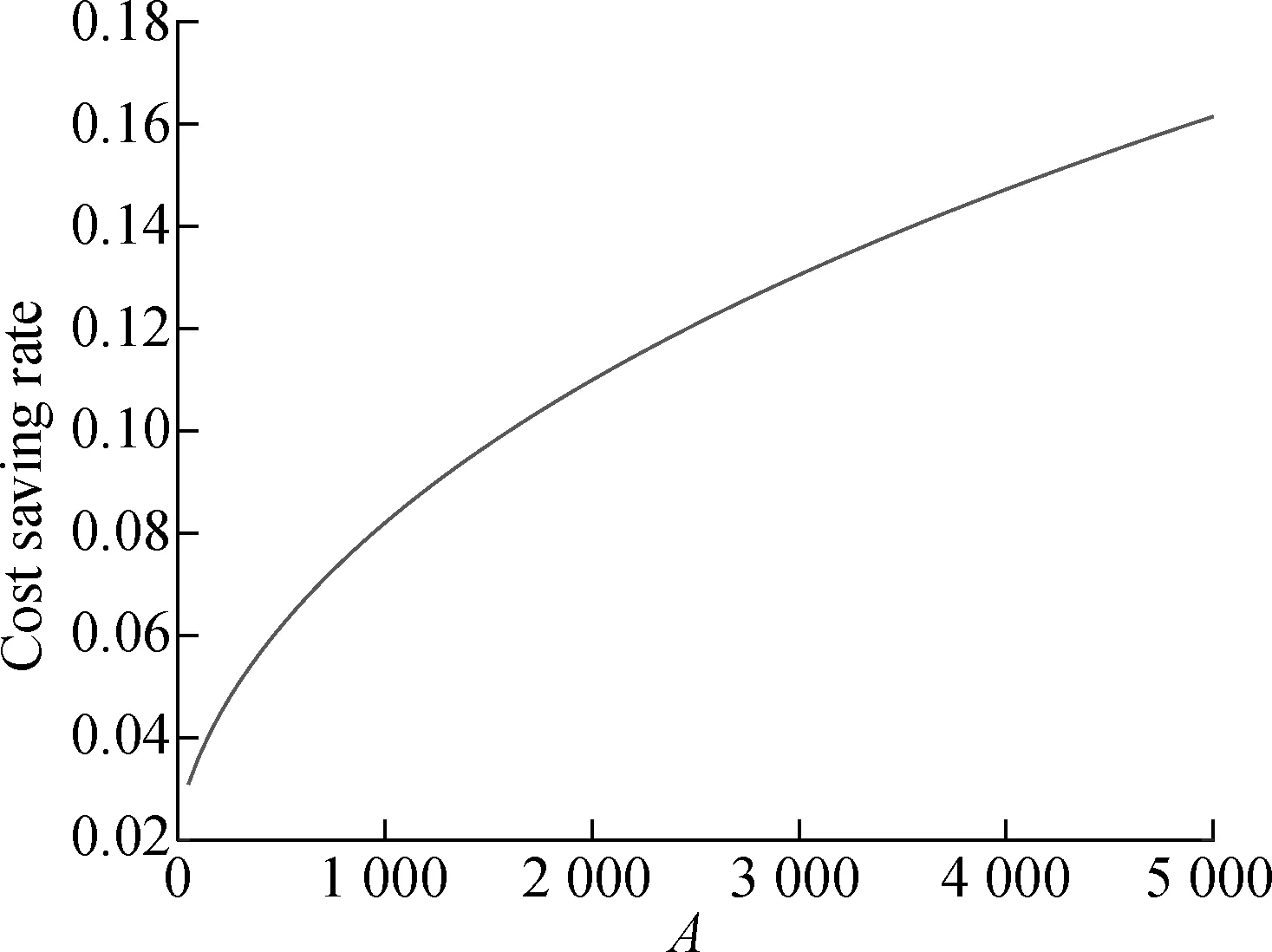
(b)

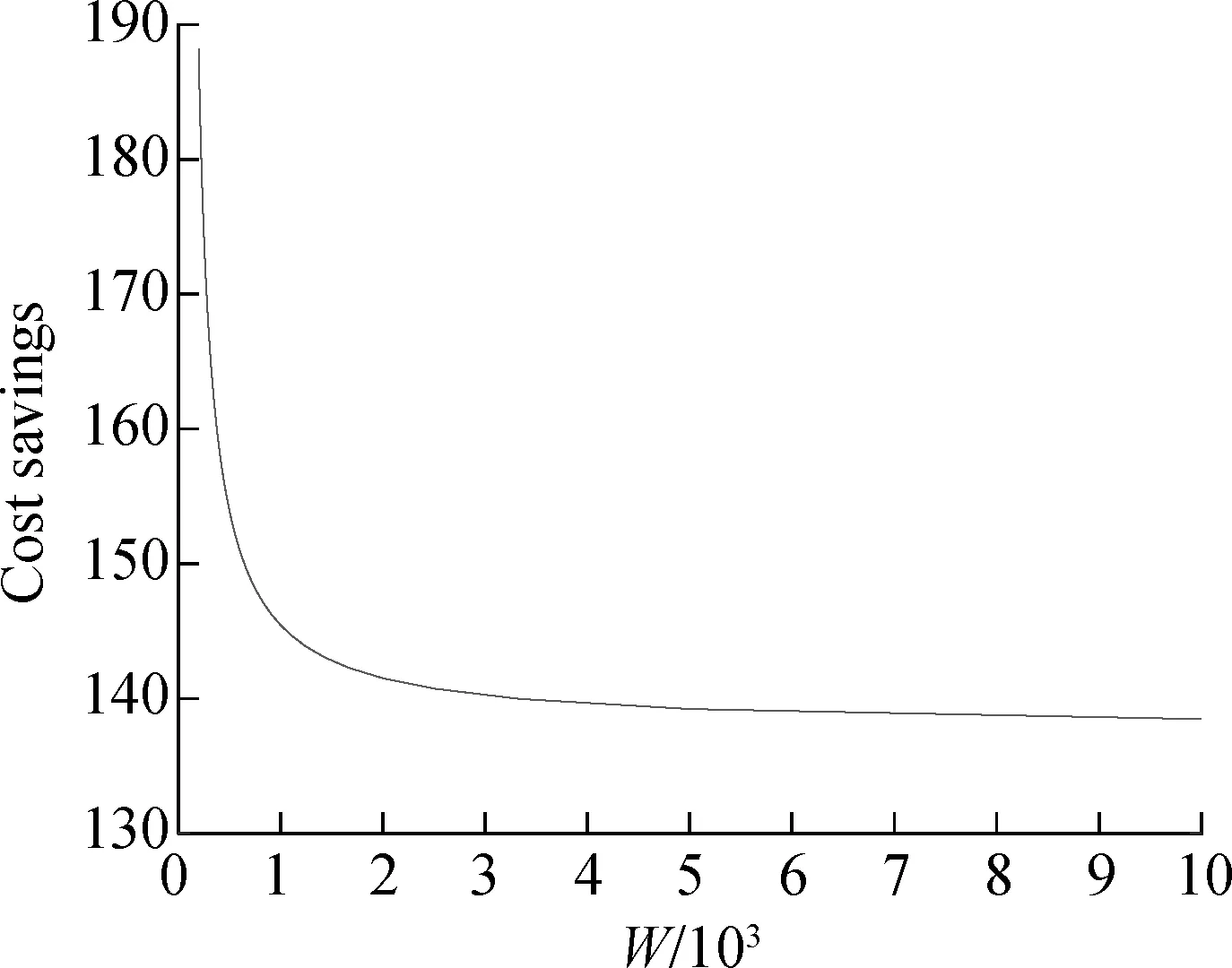
(a)
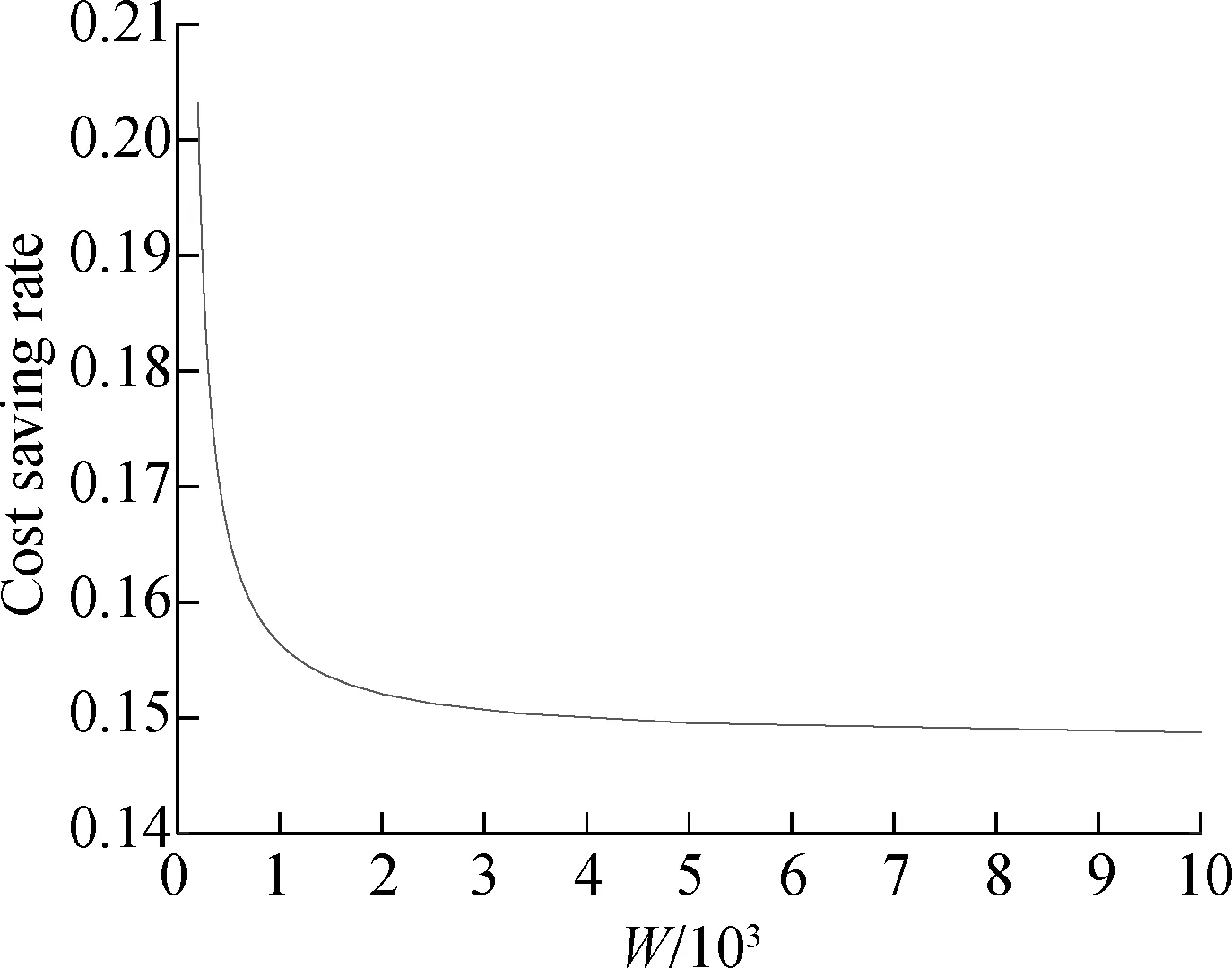
(b)
Finally, we investigate the impact of safety inventory level on the cost of retailer 1, and Fig.4 shows the cost savings and the cost saving rate varies with the increase inρ. It can be seen that both cost savings and cost saving rate rise first and then fall. The cost savings is the highest whenρ=1 and the cost saving rate is the highest whenρ=1.5. Therefore,ρ=1.5 is best if retailers are more inclined to higher service levels, and the cost saving rate of retailers is the highest, and the cooperation effect is the best whenρ=1.

(a)

(b)
4.3 The coalition size and number of items’ effect on cooperation
We have proved that the joint replenishment game is sub-additive in Section 3, which means that cooperation is always fruitful. However, it is unknown how the cooperation is affected by the coalition size and the number of items, so the investigation of cost savings and cost savings with different coalition sizes and the number of items is presented in Tab.2. The demand arrival rate and the holding cost rate are generated randomly by Matlab. Other parameters are kept as formerly described in Subsection 4.1 except forlmax. Based on the experience of Subsection 4.1, letlmax=10. Then, we test the cost savings and the cost saving rate with the increase in the number of retailers and the number of items. The cost savings is the total cost of all retailers before cooperation minus the total cost after cooperation. The cost saving rate is the ratio of the cost savings to the total cost generated in non-cooperation. The number of retailers represents the coalition size, and it takes the value of 5, 10, 20, 40, 80, 160, 320. The number of itemsnin Tabs. 2,3 and 4 takes 10, 20, 40, 80,160, 320, respectively.
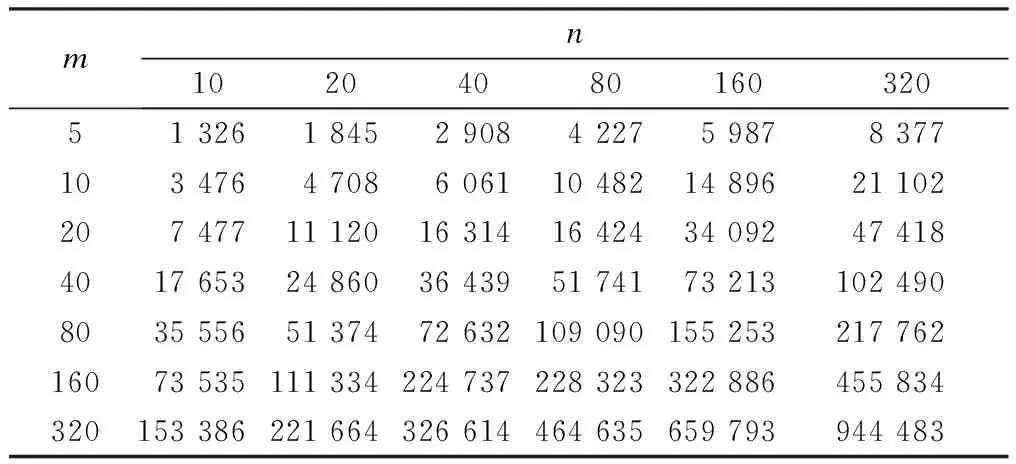
Tab.2 Cost savings of coalition

Tab.3 Cost saving rate of coalition
Observing the data of each row in Tabs.2, 3 and 4, it can be seen that the data for each row in Tab.2 is an upward trend, which indicates that cost savings increase with the increase in the number of items, meaning that cooperative coalition benefit from the joint replenishment of these products. The data in each row in Tab.3 is declining with the increase in the number of items, which indicates that the total cost savings of the cooperative coalition decrease and the effect of cooperation decreases with the increase in the number of items. When we calculate the cost savings of retailer 1, we find that it decreases when the items number increases from 40 to 80, which may lead to the dissatisfaction of the retailer. Therefore, when the number of items is greater than 40, it is recommended to carry out batch replenishment.

Tab.4 Cost savings of retailer 1
Observing the data of each column in Tabs.2, 3 and 4, it can be seen that each column of data in Tab.3 is generally on the rise as the item’s number increases, although individual data suddenly decreases. When the item number is small, the cooperative coalition’s cost saving rate can be maintained at a high level. The data in each column in Tab.2 is strictly incremental, and each set of data is more than double that of the previous data, which also verifies the subadditivity of the joint replenishment game. Each column of data in Tab.4 shows an increasing trend, but the increasing amplitude is gradually decreasing. It shows that the cost savings of a retailer after cooperation increases with the increase in the coalition’s size, but the cost saving rate decreases with the increase in the coalition’s size.
5 Conclusions
1) Considering that multiple retailers jointly replenish inventory from one supplier where the supplier offers a quantity discount and the flexible lead time to retailers, the problem is modeled as the optimization of binary functions. This paper proves that joint replenishment is beneficial to the coalition and it reduces the coalition’s total costs. The grand coalition can achieve the most significant benefit.
2) Based on cooperative game theory, a cost allocation rule of joint replenishment is designed to ensure that all participating retailers can benefit from the cooperation. It suggests the costs each retailer should bear in the joint replenishment.
3) This paper presents anη-algorithm, and the percentage error is introduced to control the approximate solution. The approximate solution can be regarded as an optimal solution if the percentage errorηis agreed by all retailers who take part in the cooperation.
4)Numerical experiments show that our solution method can quickly solve the joint replenishment problem with a large number of items. Numerical experiments also show that it can save more costs when the fixed cost and quantity discount are high, and retailers will have an increased willingness to cooperate in view of the cost. Joint replenishment may help retailers save more than 20% of their cost. The numerical experiments suggest the proposal of a safety stock level and the number of items to be joint ordered.
杂志排行
Journal of Southeast University(English Edition)的其它文章
- Mechanism of coconut husk activated carbon modified by Mn(NO3)2
- Gorenstein dimensions for weak Hopf-Galois extensions
- Research on replacement depth of black cotton soil based on cracking behavior of embankment
- Pricing decision of green supply chain under the game competition of duopolistic retailers
- Effect improvement of drug pricing reform based on multi-channel coordination
- Study on anti-faulting design process of Urumqi subway line 2 tunnel crossing reverse fault
